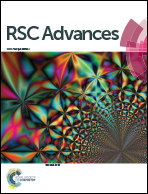A new fluorescent probe based on quinoline for detection of Al3+ and Fe3+ with “off–on–off” response in aqueous solution†
Abstract
A new quinoline-based fluorescent probe 1 has been designed and synthesized. Fluorescence emission spectra of the probe showed red-shift and obvious enhancement of fluorescent intensity upon the addition of Al3+ (turn-on). 1–Al3+ showed high selectivity for Fe3+ over other metal ions, and eliminated the interference of Al3+ during Fe3+ detection (turn-off). It showed highly selective relay recognition of Al3+ and Fe3+ via a fluorescence “off–on–off” mechanism. Fluorescence spectra indicated that the response of 1–Al3+ to Fe3+ was caused by central metal displacement. The detection limits for the analysis of Al3+ and 1–Al3+–Fe3+ ions were calculated to be 2.20 × 10−6 M and 1.96 × 10−5 M, respectively. Living HeLa cell imaging studies revealed that the probe was cell-permeable and it could be used to detect intracellular Al3+ and Fe3+ ions.


 Please wait while we load your content...
Please wait while we load your content...